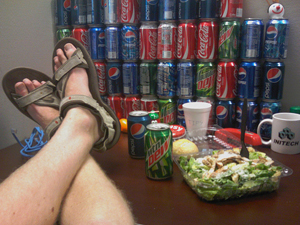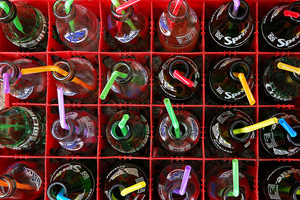Now that you have a general idea of what a summary is, you will learn how to write one. Before you can write a summary, though, you must find the main points in the text you will summarize. A good way to do this is to apply a reading strategy called chunking. Chunking is an effective strategy when you are analyzing expository texts. The primary goal of chunking is to break up the text into segments or “chunks.” The first step in this process involves reading each paragraph and then figuring out how the paragraphs relate to each other.
To understand how chunking works, read a short excerpt of an article from the New York Times that discusses the idea of gawky teenagers. As you read the four paragraphs, see if you can tell where the introduction ends. You may think it ends immediately after the first paragraph, but many times the introduction is more than one paragraph. As you decide, think about how you can justify your decision. Often there isn’t one right way to chunk text. It’s all about how you view the organization of what you’ve read and how well you can support your opinion.

Source: “Adam HDR,” majicdolphin, Flickr
Are Gawky Adolescents
More Injury-Prone?
By Gretchen Reynolds
Does the onset of puberty make a young athlete more clumsy? Many of us, particularly the parents of budding adolescents, would answer with a resounding yes. But it’s a question that has intrigued and vexed scientists and coaches for some time, and it has implications for how young athletes should be trained.
Children long have been thought to suffer through a physically gawky stage during the so-called tween years, beginning around age 11 or 12. It’s a time when most parents worry that their children are at particularly high risk of hurting themselves on the playing field, and there is some evidence, though limited, that sports injuries do spike around this time. A nationwide study from last year of running-related injuries in young people ages 6 to 18 found that 13-year-olds were the most likely to get hurt, and that typically, their injuries were caused by falls; the youngsters seemed to be tripping over their own growing feet. Similarly, epidemiological studies of knee injuries in female athletes have found that they occur far more commonly after a girl has entered puberty and undergone a growth spurt.
But other recent exercise science, somewhat surprisingly, has not been able to confirm the existence of an adolescent awkward stage. A few years ago, when scientists at the State University of New York at Buffalo tested 60 adolescent boys and girls on a series of tests of motor skills, they found that, consistently, the youngsters who’d begun puberty performed better than the children who had not. They ran faster, jumped farther and threw a ball a greater distance than the less physically mature children. The researchers concluded that there was no evidence of a physically awkward developmental period during puberty, only of consistent physical improvements.
Now, a review article in The British Journal of Sports Medicine sheds new light on why the teenage awkward phase may be so hard for scientists to detect. It may be a result of the subtlety of the growth period’s effects—and reflect the fact that it involves not just the changing adolescent body but the even more mutable adolescent brain.
Let’s look at this text together. Obviously the first paragraph is part of the introduction, but what about the second paragraph? The second paragraph is also part of the introduction because it continues to introduce the topic by discussing specifics such as the age of the children in the study and the kinds of injuries they have had. However, there is evidence to suggest that the second paragraph might be separate from the first paragraph because the end of the second paragraph discusses the findings of a study done last year. Do you see what I’m doing here? I’m having a conversation with myself in order to decide how to divide or “chunk” this excerpt. Chunking, then, is a reading strategy that an individual reader can use to divide up the information in a way that makes sense to that person.
Now let’s look at the last two paragraphs. Separating them seems like a good idea because each one contains distinctly different information. The third paragraph says that studies show that there’s not really a gawky age. In fact it’s just the opposite; teenagers are better athletes when they reach puberty. The last paragraph contradicts the third paragraph with different information.
This excerpt also doesn’t have a conclusion, but when you read a text, you must make the same decisions about the conclusion that you make about the introduction. Sometimes the conclusion will also contain several paragraphs.
Again, you are the one who decides how to chunk a text. Reading carefully and thinking about the article will help you divide text in a way that allows you to summarize the reading assignment effectively.

Source: “Healthy Lunch?” slworking2, Flickr
Now, read a complete article from the New York Times about a study related to teens and caffeine and follow these steps:
- Read through the article completely and ignore the boxes.
- Decide how to divide the text into related segments.
- Check the box after the paragraph that you think completes a chunk. When “Correct” appears, it means that you agree with how I chunked the text.
Note: The text could be chunked or divided differently, but the point of this exercise is to look for similar ideas and language that naturally connect paragraphs. These connections will help you chunk the text.
Teenagers Prefer Drinks with Caffeine
By Tara Parker-Pope
(1) Super-caffeinated energy drinks with names like Red Bull and Monster are increasingly popular among teenagers. But is it savvy marketing or the caffeine that keeps teenagers coming back for more?
(2) New research from the University at Buffalo suggests that adding caffeine to a beverage increases its appeal among young people—even when they don’t know the drink contains caffeine.
(3) To study the effect of caffeine on taste preference, the researchers first set out to create new drink flavors that weren’t familiar to their test subjects. Using a combination of Kool-Aid and flavored carbonated water, the researchers concocted seven new drink flavors, including vanilla-orange and lime-pomegranate. Then they asked 100 young people, ages 12 to 17, to rank their favorites.
(4) The scientists then picked each child’s fourth-ranked drink. Half the students were given the drink with caffeine added, while the other half, acting as a placebo group, were given the version of the drink without caffeine.
(5) Over the next four days, the students came back to the lab to taste the drink and rank their preference for it on a scale of 0 to 100. Notably, among the placebo drinkers, there was no change in the students’ flavor ratings over the four-day tasting period. But among those students who were unknowingly drinking a caffeinated version of the drink, the flavor ratings improved each day, rising by 20 to 25 percent over the four days.
(6) “Every day, the association with that flavor and the feeling it gave them increased their liking just a little bit,” said Jennifer Temple, an author of the study and assistant professor in the department of exercise and nutrition science. Dr. Temple and colleagues are presenting the study on Friday at the annual meeting of the Society for Study of Ingestive Behavior in Clearwater, Fla.
(7) Dr. Temple said the study suggests that the presence of caffeine in a beverage influences a child’s taste preferences. That said, the study data weren’t conclusive. On the sixth day of testing, the students were given all seven drinks again and asked to rate them. Even though they had tasted their fourth-favorite flavor repeatedly over the past four days, it remained in fourth place.
(8) In conducting the research, the researchers told the students they were part of a study testing a variety of drink additives, including flavors, artificial sweeteners, carbonation and caffeine. Follow-up testing at the study’s end showed that the students were no more likely to guess the beverage had caffeine in it than any of the other additives, showing that neither group was aware if they were drinking a placebo beverage or one with an additive.
(9) Dr. Temple said flavor and packaging likely influence a child’s drink choice. But once they have made a choice, over time children appear to develop a stronger preference for drinks with caffeine.
(10) “The pairing between the flavors and the way caffeine makes them feel reinforces their propensity for drinking these drinks,” she said. “The caffeine is what makes these drinks so reinforcing to children and so liked.”
 The boxes below represent the chunks that you created. Read through each chunk and use your notes to write down its main idea. When you’re finished, check your understanding to see a possible response.
The boxes below represent the chunks that you created. Read through each chunk and use your notes to write down its main idea. When you’re finished, check your understanding to see a possible response.
Source: “Healthy Lunch?” slworking2, Flickr
Chunk 1
(1) Super-caffeinated energy drinks with names like Red Bull and Monster are increasingly popular among teenagers. But is it savvy marketing or the caffeine that keeps teenagers coming back for more?
(2) New research from the University at Buffalo suggests that adding caffeine to a beverage increases its appeal among young people—even when they don’t know the drink contains caffeine.
Sample Response:
Research suggests that caffeine rather than marketing alone increases the appeal of caffeinated drinks.
Chunk 2
(3) To study the effect of caffeine on taste preference, the researchers first set out to create new drink flavors that weren’t familiar to their test subjects. Using a combination of Kool-Aid and flavored carbonated water, the researchers concocted seven new drink flavors, including vanilla-orange and lime-pomegranate. Then they asked 100 young people, ages 12 to 17, to rank their favorites.
(4) The scientists then picked each child’s fourth-ranked drink. Half the students were given the drink with caffeine added, while the other half, acting as a placebo group, were given the version of the drink without caffeine.
(5) Over the next four days, the students came back to the lab to taste the drink and rank their preference for it on a scale of 0 to 100. Notably, among the placebo drinkers, there was no change in the students’ flavor ratings over the four-day tasting period. But among those students who were unknowingly drinking a caffeinated version of the drink, the flavor ratings improved each day, rising by 20 to 25 percent over the four days.
Sample Response:
This chunk focuses on the way the study was designed, showing that even drinks with little appeal became popular once the caffeine was added.
Chunk 3
(6) “Every day, the association with that flavor and the feeling it gave them increased their liking just a little bit,” said Jennifer Temple, an author of the study and assistant professor in the department of exercise and nutrition science. Dr. Temple and colleagues are presenting the study on Friday at the annual meeting of the Society for Study of Ingestive Behavior in Clearwater, Fla.
(7) Dr. Temple said the study suggests that the presence of caffeine in a beverage influences a child’s taste preferences. That said, the study data weren’t conclusive. On the sixth day of testing, the students were given all seven drinks again and asked to rate them. Even though they had tasted their fourth-favorite flavor repeatedly over the past four days, it remained in fourth place.
(8) In conducting the research, the researchers told the students they were part of a study testing a variety of drink additives, including flavors, artificial sweeteners, carbonation and caffeine. Follow-up testing at the study’s end showed that the students were no more likely to guess the beverage had caffeine in it than any of the other additives, showing that neither group was aware if they were drinking a placebo beverage or one with an additive.
(9) Dr. Temple said flavor and packaging likely influence a child’s drink choice. But once they have made a choice, over time children appear to develop a stronger preference for drinks with caffeine.
Sample Response:
The study was inconclusive but does suggest that adding caffeine influences a teen’s choice of drink.
Chunk 4
(10) “The pairing between the flavors and the way caffeine makes them feel reinforces their propensity for drinking these drinks,” she said. “The caffeine is what makes these drinks so reinforcing to children and so liked.”
Sample Response:
This chunk restates the finding and makes the concluding statement that caffeine is what makes these drinks desirable to teenagers.